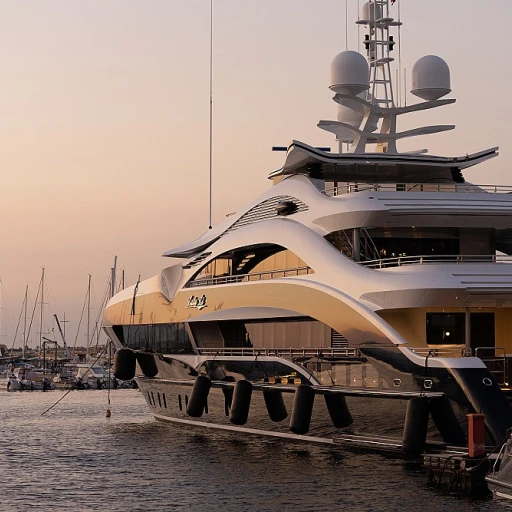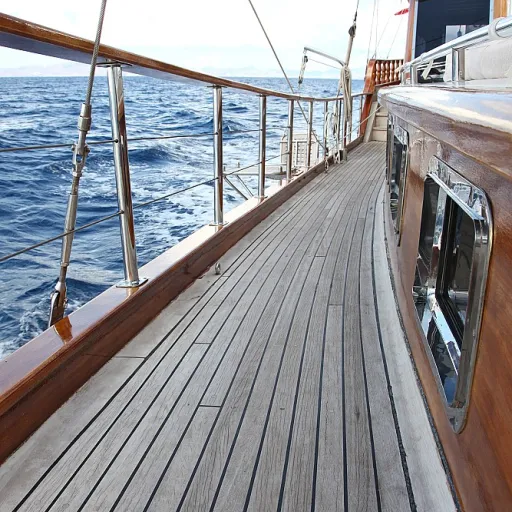
Understanding Rubber's Versatility in Yachting
Exploring the Power of Rubber in Modern Yachting
In the world of yachting, the humble yet mighty material known as rubber plays a significant role. Renowned for its versatility, rubber finds itself utilized in various forms across luxury vessels, extending beyond its usual perception. From rubber flooring to silicone seals, its presence is ubiquitous, ensuring both functionality and elegance.
Rubber's flexibility sets it apart, making it a material of choice for numerous applications. It contributes not only to the aesthetic appeal of yachts but also significantly enhances the craft's performance. For instance, rubber mats and anti-slip surfaces provide a secure footing, crucial for maintaining stability in both serene and turbulent waters.
Among the many applications, rubber is integral in mats anti-slip and fenders, where it absorbs shock and reduces noise, thereby ensuring the comfort and safety of those on board. Beyond its practical uses, the eco-friendliness of recycled rubber aligns with the industry's sustainability goals, offering a mindful approach to marine design and function.
For yachtsmen aiming to enhance the comfort of their vessels, understanding the power of rubber is essential. This versatile material is not just about adding to the boat's aesthetics; it defines the quality of the journey. Enhancing comfort on your sailboat involves a symbiotic relationship with materials like rubber, incorporating its benefits into daily life at sea.
The seamless integration of rubber into yacht construction and maintenance highlights its importance. Whether you're cruising on a rubber boat or enjoying the stability provided by rubber matting, the necessity of this material in boating cannot be overstated.
Safety First: Rubber's Contribution to Onboard Security
Ensuring Safety with Rubber Elements on Board
When one thinks of safety on yachts, rubber might not immediately come to mind. Yet, it's a fundamental material ensuring a safe experience for all aboard. The right choice of rubber components can prevent accidents and enhance the overall safety of any boat.
Slips and falls are among the most common onboard incidents, often caused by wet or unsteady surfaces. Incorporating anti-slip rubber mats and rubber flooring throughout the yacht significantly reduces these risks. With textured surfaces designed to provide added grip, these materials help maintain stability, even in adverse weather.
In addition to flooring, rubber plays a crucial role in other key safety aspects. For instance, rubber seals and gaskets ensure water-tight integrity, preventing potential ingress of water that could destabilize or damage a boat. This attention to detail is critical in maintaining yacht safety, making the use of quality rubber components indispensable.
Moreover, rubber's versatile nature means it is heavily utilized in fenders, protecting the yacht from collisions and abrasions during docking. The resilience of rubber fenders helps absorb impacts, safeguarding both the vessel and its passengers.
For those keen on navigating the essentials of safety further, exploring the intricacies of a boat instrument panel can offer valuable insights into merging technology with traditional safety measures.
By making informed decisions on rubber's implementation, yacht owners can enjoy the assurance of enhanced safety, which is paramount in every voyage.
Performance Enhancement Through Rubber Technology
Enhancing Boat Performance through Innovative Rubber Solutions
In the competitive world of yachting, where performance is a prized asset, rubber plays a paramount role in pushing the boundaries of what boats can achieve. From flooring to gaskets and seals, this versatile material contributes significantly to the enhancement of a boat's overall capabilities. Modern rubber technology offers advanced solutions with a diverse range of rubber components. For instance, custom-fabricated rubber trim enhances not just the aesthetic view but the aerodynamic efficiency of a vessel. This trim and sponge foam elements can greatly reduce drag, allowing boats to glide more effortlessly through water. Moreover, silicone rubber parts are known for their exceptional heat-resistant properties, ensuring that high-performance vessels maintain optimal functioning under demanding conditions. Flooring solutions such as rubber boat flooring and rubber matting are engineered for durability and anti-slip surface features. This rubber flooring isn't just for aesthetic appeal; it increases grip, contributing to stability even in high-speed scenarios. Rubber mats also cushion impacts, providing an anti-fatigue surface that improves comfort during long voyages. For compelling performance metrics, boats rely on robust door seals and adhesives. These components ensure the water-tight integrity of a vessel, while also optimizing energy efficiency by maintaining the ideal internal environment. Additionally, fenders made from specialized rubber compounds like recycled rubber or sponge rubber absorb significant impact, protecting the hull during docking operations. Notably, cutting-edge adhesives and gaskets play a crucial role in structural integrity and longevity. With high-performance boats pitching through waves, resistance to pressure is paramount. The use of innovative rubber adhesives ensures that joints and seals remain secure and resilient, enabling the vessel to perform with excellence. The continual advancement in rubber materials manifests in the form of heat-resistant seals and parts that accommodate the dynamic shifts in temperature endured by high-speed vessels. It's clear that the modern yacht thrives on the intricate dance of performance-oriented parts crafted from this vital material. For a broader understanding, delve into the importance of masthead lights which complement these innovations in securing superior on-water performance.Sustainability and Rubber: Eco-Friendly Innovations
Sustainability in Yachting: Rubber's Environmental Impact
In the world of modern yachting, sustainability is quickly becoming a key priority. Fortunately, rubber components are playing an important role in this green transition as eco-friendly innovations emerge. From recycled rubber to sustainable production methods, the impact of rubber on the environment is being closely considered to reduce the ecological footprint of yachting.
One significant way that rubber enhances sustainability is through the use of products made from recycled materials. Recycled rubber components, such as boat flooring, fenders, and mats, are becoming increasingly popular due to their lower environmental impact compared to traditional materials. These components not only reduce the amount of new material produced but also help minimize waste by repurposing existing rubber products.
The choice of production materials is crucial in creating a sustainable yacht. This is where innovative materials like silicone rubber and sponge rubber come into play. These options provide durability and flexibility while delivering eco-friendly solutions that do not compromise on performance or safety.
Additionally, switching to rubber products can help in reducing fuel consumption through lightweight designs. Rubber parts, such as gaskets and seals, contribute to improved energy efficiency by minimizing air and water leaks. This results in optimized performance for the yacht, leading to reduced fuel consumption and, consequently, lower emissions.
The ongoing development of heat-resistant and anti-slip flooring solutions made from rubber is another steppingstone toward sustainable yachting. These advancements not only ensure the safety of crew and passengers but also extend the lifespan of the items, reducing the need for frequent replacements and thereby conserving resources.
As the industry moves forward, it's clear that rubber's role in sustainability will continue to grow. By embracing these eco-friendly innovations, yacht owners and manufacturers can contribute positively to the environment while enjoying the many benefits that rubber products have to offer on board.













